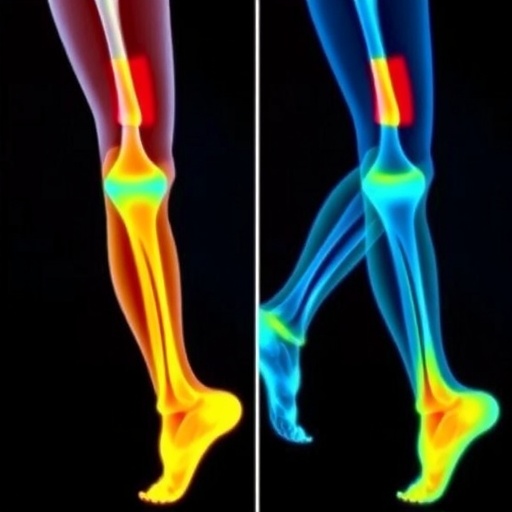In a significant advancement in the field of biomedical engineering, researchers have developed a groundbreaking deep learning framework known as Gait-to-Contact (G2C) which holds promise for predicting wear on total knee replacements by analyzing gait patterns. This innovative approach has emerged as a response to the pressing need for improved predictive capabilities regarding the longevity and functionality of knee implants, a vital aspect of orthopedic surgery that affects millions of patients worldwide.
The need for effective monitoring and prediction of joint wear cannot be overstated. Total knee replacement is a common surgical procedure, particularly among elderly patients suffering from conditions such as osteoarthritis. Post-surgery, an artificial knee joint is expected to last several years, but factors like patient activity level, comorbidities, and mechanically-induced stresses can significantly influence wear and tear. The challenge has always been to efficiently and accurately assess the rate of wear over time—this is where G2C comes into play.
The G2C framework employs state-of-the-art deep learning algorithms that analyze the intricate patterns of an individual’s gait. By harnessing the vast amount of data collected through gait analysis, the G2C model can predict the specific wear rate of total knee replacements based on that individual’s unique movement patterns. The application of artificial intelligence in this context opens new avenues for personalized medicine, allowing healthcare providers to tailor post-operative rehabilitation programs that could extend the life of the joint prosthesis.
A crucial aspect of the G2C framework lies in its ability to identify subtle changes in gait that may signal impending problems with knee implants. Conventional methods of wear prediction rely predominantly on wear simulations in laboratory settings or postoperative imaging studies, which may not fully capture the real-world complexities of daily movements. In contrast, the G2C’s machine learning model continually learns and adapts as more gait data is collected, offering increasingly accurate predictions that can be tailored to individual patients by integrating historical movement data and outcomes.
In their comprehensive study, the research team, led by experts Perrone, Simmons, and Malloy, employed a substantial dataset that included gait patterns from a diverse array of subjects, varying in age, sex, and physical condition. This level of diversity enhances the model’s robustness, ensuring that its predictions are applicable across a wide range of patients. The researchers meticulously calibrated the G2C algorithm to accommodate variations in gait mechanics, ensuring that the predictions hold true for both healthy individuals and those with pre-existing joint issues.
This predictive capability also underscores an important shift within orthopedic care towards proactive monitoring. The notion of harnessing machine learning to preemptively address potential joint wear drives home the importance of preventative care in medicine. By employing the G2C framework, healthcare providers can now identify patients at risk of excessive wear due to their unique gait patterns and intervene earlier with preventive measures—be it through specific physical therapy regimens, lifestyle changes, or alternate surgical techniques.
Moreover, the implications of the G2C framework extend beyond individual patient care. In the broader healthcare landscape, early prediction of knee implant wear can significantly decrease healthcare costs by reducing the need for revision surgeries—proceedings that are not only costly but also carry inherent risks and complications. Current estimates suggest that revision knee surgeries can cost between $20,000 to $40,000, depending on the complexity of the case. A significant reduction in the frequency of these surgeries could translate to substantial savings for healthcare systems worldwide.
The potential for implementing G2C does not stop with knee replacements; the underlying technology can be applied to various orthopedic implants and conditions. By recognizing the intricate connections between gait patterns and implant performance, this novel framework could pave the way for similar predictive models focusing on hip, shoulder, and even spinal implants. The diversification of applications enriches the field and propels forward the integration of machine learning technologies in orthopedic practices.
Another fascinating aspect of this research is the interdisciplinary collaboration that was essential to its success. The team comprised not only biomedical engineers but also experts in machine learning and biomechanics. This melding of fields showcases the value of collaborative efforts in technological innovation—bringing together diverse perspectives and expertise can lead to outcomes that may not have been achievable in isolation. The contributions from various disciplines underscore the importance of fostering an environment that encourages such collaborations to tackle complex healthcare challenges effectively.
As the field of artificial intelligence continues to evolve, the implications of research like G2C will undoubtedly expand. Continuous improvement of machine learning algorithms combined with more expansive datasets will further enhance predictive capabilities. Additionally, the ongoing refinement of data collection methods, such as wearable technology and mobile health applications, will ensure that gait pattern data is even more accessible for analysis, creating a feedback loop that can continuously improve predictions over time.
In conclusion, the introduction of the Gait-to-Contact framework represents a monumental stride in the realm of orthopedic engineering, offering a more accurate and individualized approach to predicting knee replacement wear from gait patterns. As researchers and clinicians embrace these innovations, personalized medical care will likely become the standard, transforming patient outcomes and experiences dramatically. Observers in the medical and engineering communities eagerly anticipate further developments stemming from this and similar work in the future, as such advancements are poised to redefine the possibilities of rehabilitation and implant longevity.
Subject of Research: Predicting total knee replacement wear through gait analysis using a deep learning framework.
Article Title: Gait-to-Contact (G2C): A Novel Deep Learning Framework to Predict Total Knee Replacement Wear from Gait Patterns.
Article References:
Perrone, M., Simmons, S., Malloy, P. et al. Gait-to-Contact (G2C): A Novel Deep Learning Framework to Predict Total Knee Replacement Wear from Gait Patterns.
Ann Biomed Eng (2025). https://doi.org/10.1007/s10439-025-03863-3
Image Credits: AI Generated
DOI:
Keywords: Total knee replacement, wear prediction, gait analysis, deep learning, orthopedic engineering.




